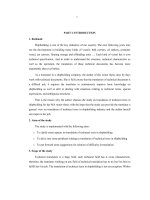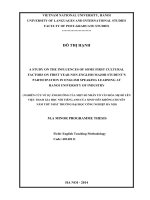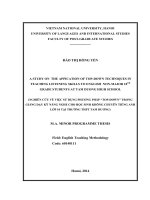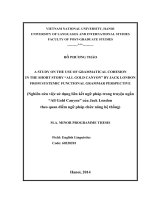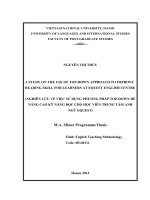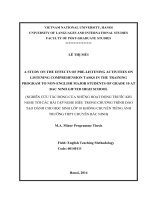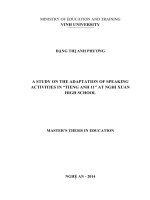Study on the cultivation of green algae dunaliella salina raceway pond system (khóa luận tốt nghiệp)
Bạn đang xem bản rút gọn của tài liệu. Xem và tải ngay bản đầy đủ của tài liệu tại đây (944.65 KB, 60 trang )
HỌC VIỆN NƠNG NGHIỆP VIỆT NAM
KHOA CƠNG NGHỆ SINH HỌC
----------------
KHĨA LUẬN TỐT NGHIỆP
ĐỀ TÀI:
“STUDY ON THE CULTIVATION OF GREEN ALGAE
DUNALIELLA SALINA IN RACEWAY POND SYSTEM”
Người thực hiện: BÙI QUANG HIỆP
Lớp: K61CNSHE
Chuyên ngành: Công nghệ Sinh Học - Biotechnology
Giáo viên hướng dẫn: PGS.TS. Nguyễn Đức Bách
HÀ NỘI – 3/2021
DECLARATION
I hereby certify that this is my own research. The data and results in the
thesis are true and they have never been published in any research work.
I hereby certify that the information cited in the thesis has been clearly
sourced.
Hanoi, March
NAME
i
2021
ACKNOWLEDGEMENT
First of all, I would like to express my gratitude to my Assoc. Prof. Dr.
Nguyen Duc Bach, who enthusiastically guided and helped me in the implement
of the thesis.
I would like to thank the Department of Molecular Biotechnology and
Insitute for Research and Development of Microalgae of Vietnam National
University of Agriculture for creating favorable conditions to allow me to
conduct experiments in my graduation thesis.
I also would like to send thanks to Ms. Phi Thi Cam Mien, Mr. Tuan, Ms.
Hien and all interns for assist me for my thesis.
My special thanks approve to my parents for their endless love, care and
have most assistances and motivation me for the whole of my life. I also would
like to explain my thanks to my siblings, brothers and sisters for their support
and care me all the time.
ii
TABLE OF CONTENS
DECLARATION.......................................................................................... i
ACKNOWLEDGEMENT .......................................................................... ii
LIST OF FIGURES.................................................................................... vi
LIST OF TABLES .................................................................................... vii
ABSTRACT .............................................................................................. viii
PART 1: INTRODUCTION ...................................................................... 1
1.1. Problem statement................................................................................ 1
1.2. Purpose and requirement ..................................................................... 2
1.2.1. Purpose............................................................................................... 2
1.2.2. Requirement ...................................................................................... 2
PART 2: LITERATURE REVIEW........................................................... 3
2.1. Overview of the Dunaliella salina ..................................................... 3
2.1.1. Taxonomic, morphological and biological characteristics of
Dunaliella salina ......................................................................................... 3
2.1.1.1. Taxonomy of Dunaliella salina ................................................... 3
2.1.1.2. Morphology of Dunaliella salina ................................................ 4
2.1.1.3. Biology characteristics of Dunaliella salina .............................. 6
2.1.2. Factors affecting the growth of Dunaliella salina......................... 9
2.1.3. Application of Dunaliella salina ................................................... 13
2.2. Studies on Dunaliella salina ............................................................. 16
2.2.1. Studies on Dunaliella salina in Vietnam ..................................... 16
2.2.2. Studies on Dunaliella salina in the world .................................... 17
iii
2.3. Algae biomass production by Raceway pond ................................. 18
2.3.1. Introduction of the Raceway pond ................................................ 18
2.3.2. Typical configuration of the Raceway pond ................................ 18
PART 3: RESEARCH METHODOLOGY ............................................ 21
3.1. Research subjects ............................................................................... 21
3.2. Study time and place.......................................................................... 21
3.3. Chemicals............................................................................................ 21
3.4. Research equipments ......................................................................... 23
3.5. Research methods .............................................................................. 24
3.5.1. Determination of cell density by Neubauer counting chamber .. 24
3.5.2. Determination of specific growth rate .......................................... 25
3.5.3. Determination of the optimal culture medium............................. 26
3.5.4. Effect of temperature on the growth of Dunaliella salina.......... 27
3.5.5. Effect of light intensity on the growth of Dunaliella salina ...... 28
3.5.6. Effect of salinity on the growth of Dunaliella salina ................. 29
3.5.7. The growth of Dunaliella salina in Raceway pond .................... 30
3.6. Data analysis....................................................................................... 30
PART 4: RESULTS AND DISCUSSION.............................................. 31
4.1. Preservation of Dunaliella salina ..................................................... 31
4.2. Determination of the optimal culture medium ................................ 32
4.3. Effect of temperature on the growth of Dunaliella salina ............. 34
4.4. Effect of light intensity on the growth of Dunaliella salina.......... 37
4.5. Effect of salinity on the growth of Dunaliella salina..................... 39
4.6. The growth of Dunaliella salina in raceway pond ......................... 42
iv
PART 5: CONCLUSIONS AND RECOMMENDATIONS ................ 44
5.1. Conclusions ........................................................................................ 44
5.2. Recommendations .............................................................................. 44
REFERENCES .......................................................................................... 45
v
LIST OF FIGURES
\
Fig 2.1. Taxonomic hierarchy of Dunaliella salina ......................................... 3
Fig 2. 2. Morphology of green microalgae Dunaliella salina ........................... 5
Fig 2. 3. Morphology of some species in the genus Dunaliella salina .............. 6
Fig 2. 4. The life cycle of Dunaliella salina. ................................................... 8
Fig 2. 5. A top view of a raceway pond as typical used for algal biomass
production ....................................................................................................19
Fig 3. 1. Neubauer counting chamber……………………………………… ....24
Fig 3. 2. Investigation of the optimal medium for the growth of Dunaliella
salina ...........................................................................................................26
Fig 3. 3. Investigation of the optimal temperature for the growth of Dunaliella
salina ...........................................................................................................27
Fig 3. 4. Investigation of the optimal light intensity for the growth of Dunaliella
salina ...........................................................................................................28
Fig 3. 5. Investigation of the optimal salinity for the growth of Dunaliella salina
....................................................................................................................29
Fig 4. 1. Preservation of Dunaliella salina in liquid medium………………….31
Fig 4. 2. Growth rate of Dunaliella salina in different medium for 2 weeks ....33
Fig 4. 3. Specific growth rate of Dunaliella salina in different medium ...........33
Fig 4. 4. Growth rate of Dunaliella salina in different temperature .................35
Fig 4. 5. Specific growth rate of Dunaliella salina in different temperature .....36
Fig 4. 6. Growth rate of Dunaliella salina in different light intensity ..............38
Fig 4. 7. Specific growth rate of Dunaliella salina in different light intensity ..38
.Fig 4. 8 Growth rate of Dunaliella salina in different salinity ........................40
Fig 4. 9. Specific growth rate of Dunaliella salina in different salinity ............41
vi
LIST OF TABLES
Table 4. 1. Cell density for 2 weeks of Dunaliella salina in different medium ... 32
Table 4. 2. Growth density of Dunaliella salina in different temperature for 2
weeks............................................................................................................. 35
Table 4. 3. Cell density of Dunaliella salina in different light intensity for 2
weeks............................................................................................................. 37
Table 4. 4. Cell density of Dunaliella salina in different salinity for 2 weeks .... 40
Table 4. 5. Total cell count of Dunaliella salina cultured in raceway pond ........ 42
vii
ABSTRACT
The microalgae Dunaliella salina is the best commercial source of natural
-carotene. In this study, the growth of Dunaliella salina algae will be evaluated
by culture medium and other conditions such as temperature, light intensity and
salinity. To determine the optimal culture medium, three types of media
commonly used to evaluate the growth of Dunaliella salina is F/2 media, Walne
media and J/l media. To investigation of the optimal temperature, Dunaliella
salina was experimented at 3 different temperature were 18-22℃, 24-28℃ and
outdoor temperature.To investigation of the optimal light intensity, Dunaliella
salina was experimented at 3 different light intensity were 10Klux, 12Klux and
14Klux. To investigation of the optimal salinity, Dunaliella salina was
experimented at 5 different salinity were 0.5M, 1M, 1.5M, 2M, 2.5M.
The result of experiment show that F/2 medium is best optimal media for
cultivate Dunaliella salina algae and the optimal conditions of this algae is at
temperature 24-28℃, light intensity 14Klux and 1M salinity. Then the
experimental results was used to cultivate biomass in the raceway pond system.
viii
PART 1: INTRODUCTION
1.1. Problem statement
Nowadays, microalgae are used as nutrient supplements for human
consumption because of high proteins, vitamins and polysaccharides content..
Currently and in the future, the use of algae will develop in the energy sector,
food production and many other applications in life. -carotene, protein,
polysaccharide, unsaturated fatty acids are compounds in the composition of
microalgae that have been exploited and used by humans. Dunaliella salina is a
rare single-celled algae found in high salt concentration environments. It
adapted to survive in highly salty environments by accumulating large amounts
of β-carotene to shield them from UV radiation. β-carotene has great potential in
applying biotechnology for commercial purposes such as cosmetics or
functional foods.
Dunaliella salina contains the richest source of β-carotene. Accumulating
β-carotene requires high salinity, high temperature and high light intensity.
Studies have shown that at salinity above 27% NaCl, Dunaliella salina can
accumulate carotenoids up to 14% dry weight and active more than plant
carotenoids. β-carotene plays an important role in preventing the development of
cancer, enhancing human vision, ulcers, aging. Vietnam is a tropical country
with great sea potential with a coastline of more than 3200km and famous salt
fields such as Sa Huynh, Cam Ranh, Can Gio, Long Dien. So Vietnam has
economic potential are great for growing Dunaliella salina algae. However, in
Vietnam, there is very little research on the optimal growth conditions of
Dunaliella salina and β-carotene biosynthesis. So the thesis “Study on the
cultivation of green microalgae Dunaliella salina in raceway pond system” was
chosen to determine the optimal conditions for the growth of Dunaliella salina
and cultivation of them in raceway pond system.
1
1.2. Purpose and requirement
1.2.1. Purpose
Study on cultivation of the green algae Dunaliella salina in raceway pond
system.
1.2.2. Requirement
Determination of the optimal culture medium for the growth of Dunaliella
salina algae.
Determination of the optimal conditions for the growth of Dunaliella salina
algae.
Cultivation of algae biomass in the raceway pond system.
2
PART 2: LITERATURE REVIEW
2.1. Overview of the Dunaliella salina
2.1.1. Taxonomic, morphological and biological characteristics of Dunaliella
salina
2.1.1.1. Taxonomy of Dunaliella salina
Dunaliella salina is a green algae that now belong to the genus Dunaliella
and phylum Chlorophyta. [Avron and Ben-Amotz 1992; Garcia et al., 2007].
The current taxonomy of the genus is based on morphological and physiological
attributes including the ability of some species to grow over wide salinity ranges
and at extreme salinities, as well as the accumulation of high levels of βcarotene.
Fig 2.1. Taxonomic hierarchy of Dunaliella salina
In the early 18th century, scientists thought that Dunaliella resembled
Haematococcus, but in the second half of the 19th century, they found that the
genus was different from Haematococcus and named it Dunaliella [Avron and
Ben-Amotz 1992]. Up to now, 28 Dunaliella species have been recognized.
3
These include five species that live in freshwater and are rarely present, while 23
of these species are present in salty environments. [Borowitzka & Siva, 2007].
2.1.1.2. Morphology of Dunaliella salina
Dunaliella salina is vegetative motile cells. The cell shape of Dunaliella
salina varies from ellipsoid, ovoid, cylindrical and pyriform to almost spherical.
Adult green cells range from 5.6-15.4μm in length and 3.8-12.6μm in width;
Cells of this algae may change shape with changing conditions, often becoming
spherical under unfavorable conditions. A rigid wall is lacking, but there is a
distinctive mucilaginous cell coat. The two flagella are apically inserted, equal
in length, and usually exhibit a homodynamic pattern of beating. The two basal
bodies are displaced against each other and carry microtubular flagellar roots.
The single chloroplast occupies most of the cell body. This body maybe shaped
like a cup, dish, and bell and have a thicker section containing a pyrite (kernels,
starch granules, inclusions) [Borowitzka and Siva, 2007].
Anteriorly, the
chloroplast is sometimes incised into several lobes. The thylakoids of the
chloroplast are sometimes arranged in dense stacks of up to 10 units. Stacking of
thylakoids was found to be particularly pronounced in cells grown at high light
intensity and high salt concentration. Starch grains usually surround the
pyrenoid, but may also be found at other places of the chloroplast. The βcarotene globules of Dunaliella salina were found to be composed of practically
only neutral lipids, more than half of which were β-carotene. Most of the reddish
forms may lose their red color when grown at low light intensities [Sarmad et
al., 2006].
4
Fig 2. 1. Morphology of green microalgae Dunaliella salina
(A) Light micrograph of vegetative cell with a high content of β-carotene
(cell length = 23μm); (B) Two cells in the early stage of mating showing
appressed flagella and mating tube between the two cells (cell length 22μm); (C)
Transmission electron micrograph of a section of a cell of Dunaliella salina.
Scale line = 2 μm [Borowitzka and Siva, 2007].
5
Fig 2. 2. Morphology of some species in the genus Dunaliella salina
Asteromonas gracilis redrawn [Ruinen, 1938]; Brachiomonas submarina,
Brachiomonas simplex, Chlamydomonas Pulsatilla, Dunaliella maritima, and
Dunaliella salina [Butcher, 1959]; Pyramichlamys vectensis [Carter, 1937].
2.1.1.3. Biology characteristics of Dunaliella salina
Dunaliella salina is a green algae that now belongs to the phylum
Chlorophyta [Avron and Ben-Amotz 1992; Garcia et al., 2007].It lacks a rigid
6
cell wall nevertheless it can grow in aquatic environments varied salinities from
0.5M to 5M NaCl [Shariati & Hadi, 2000, Phadwal & Singh, 2003; Jahnke &
White, 2003]. Under stress condition, Dunaliella salina can accumulate
significant amounts of valuable chemical matter such as carotenoids, glycerol,
vitamins and proteins [Hadi et al., 2008]. Dunaliella salina can adapt to a wide
range of salt concentrations was shown to be based on the ability of the alga to
change its intracellular concentration of glycerol [Raja et al., 2007]. In fact, the
accumulation of glycerol in this algae is regulated by external water activity
rather than the specific solute effect [Shariati & Lilley, 1994].
The eyespot is usually distributed in the anterior part of the chloroplasts. In
Dunaliella salina, the eyespot is almost difficult to see under an optical
microscope [Avron & Ben-Amotz, 1992]. The nucleus is often obscured by a
large number of particles. It occupies most of the anterior part of the cell and is
surrounded by the anterior lobes of the plastids. Superstructure research has
shown it has a porous envelope and a single, convex nucleus surrounded by
chromatin structures. Mitochondrial structures can be observed in different parts
of the cell. The number and size of mitochondria varies greatly between cells at
different growth stages. Cells have 2 to 4 golgi forms. The endoplasmic
reticulum typically underlies the plasmalemma over most parts of the cell.
During periods of high salt stress, the endoplasmic reticulum increases in
number, and act as an artificial tank of membrane material as key cell
components contract. The vacuole is very diverse, containing a number of
cellular components and the vesicles, cysts, particles or other matter of the
cytoplasm. Larger or vacuolar lipid droplets containing smaller lipid droplets
can be found in many places within the cell [Avron & Ben-Amotz, 1992].
7
Fig 2. 3. The life cycle of Dunaliella salina
(A) Vegetative reproduction of the haploid motile cells by mitosis followed
by cytokinesis. The formation of the new second flagellum is indicated. The
formation of the palmella stage is also shown; (B) Formation of asexual resting
cysts, the aplanospores. These cysts are haploid and under favorable conditions
one or more mitotic division will occur within the cyst and the daughter
flagellated cells will be released; (C) Sexual cycle starting with the mating of
sexually two compatible strains. Following plasmogamy and karyogamy, the
diploid zygospore is formed. Under favorable conditions meiosis will occur and
the haploid daughter cells will be released from the mother spore [Borowitzka,
M.A., Siva, C.J., 2007]
Sexual reproduction is heterothallic and isogametic and is stimulated by a
reduction in salinity. Mating occurs between isomorphic (+/−) mating strains.
8
The two cells first join their flagella, beginning at the tips of the flagella. Once
the flagella have come together for most of their length, the (+) gamete then
produces a thin mating tube between its flagella which connects with the (−)
gamete between its flagella. The two cells draw together and fusion occurs from
the anterior end, by anterior-lateral fusion, leading to the formation of a zygote
with four flagella. The zygote then sheds the flagella and forms a thick, smooth,
multilayered wall (Leonardi and Caceres, 1997). Zygote germination is
generally stimulated by dilution of the medium and the contents of the
zygote become greenish before germination. During germination, meiotic
division occurs and 4–8 (16 to 32 in rare cases) cells are formed. The
number of cells formed is dependent on the size of the zygote. The motile
daughter cells are released through a break in the zygote wall [Borowitzka,
M.A., Siva, C.J., 2007].
Microalgae are autotrophic, containing many different pigments, each
group of algae has its own pigment system. Microalgae are low-level plants that
contain chlorophyll, so microalgae perform photosynthesis by the same
mechanism as higher plants. Microalgae contain 3 main groups of pigments:
Chlorophyl, Carotenoide, Phycobilin. In saltwater lakes, Dunaliella salina are
often dark red due to the accumulation of chlorophyll pigments. In the culture of
Dunaliella salina, lighting conditions such as continuous lighting or light-dark
phase affect microalgae growth and biomass composition. It is therefore
essential to provide appropriate light and dark periods in the development of
Dunaliella salina. During the day, under the influence of sunlight, algae use CO2
as raw material for photosynthesis of O2 , when there is no sunlight, algae use
𝑂2 for respiration. [Borowitzka, M.A., Siva, C.J., 2007]
2.1.2. Factors affecting the growth of Dunaliella salina
Dunaliella salina has advantage of being able to thrive in high salt
concentrations so it can be cultured in open ponds as well as in closed culture
9
systems. However, some nutrients and physiological limiting factors must be
added for optimal growth.
a. Light intensity
Light is a source of energy for photosynthesis, in experiments on algae
culture, light intensity, spectral quality and lighting cycle have a decisive effect
on growth of Dunaliella salina. Light intensity plays the most important role.
However, the need for the light intensity of the algae are different, maybe it
dependent on the species cultured, on the density of the cells, or on the depth of
the medium. When culturing with a large depth of medium and high cell density,
light intensity must be increased so that light can penetrate the medium.
However, too much light intensity can inhibit photosynthesis. Light can be
supplied naturally or provided from fluorescent lighting, but should be taken on
the interactions between natural and artificial light as it can cause the culture
temperature to increase unexpectedly [M.A.Hejazi, 2003]
Dunaliella salina is an autotrophic organism, and light is the only source of
energy for Dunaliella salina. In raceway pond system, the light source is
sunlight while in the photochemical reactors light can be provided using one of
two: white fluorescent lights or sunlight. The growth of carotenoids varies with
different types of light. Carotenoid induction is not dependent on wavelength but
it is highly dependent on light intensity. UV-A radiation produces a large
accumulation of the carotenoid of Dunaliella salina without delaying growth.
[Borowitzka and Borowitzka 1989]
b. Temperature
Temperature is an important factor for the growth of Dunaliella salina, and
this has a great influence on the living activities of organisms. The effect of
temperature on microalgae growth can be direct or indirect and often have a
simultaneous effect with the lighting regime and CO2 concentration in the
environment. Each species of algae has the suitable temperature for growth
and has different heat resistance. Temperature can reduce cell density or
10
reduce the size of cells leading to a decrease in algal biomass. [Jundishapur
J Microbiol, 2016].
The suitable temperature for microalgae growth depends on the group of
algae. Temperature for the algae living in the polar region is less than 10°C, the
temperate zone is from 10°C to 20°C, the tropics is greater than 20°C. Most
cultured species of microalgae are usually adapted at 16 - 27oC, but this value is
easy to change depending on the nutrient content of the environment and the
cultured algae. The effect of temperature on algae growth and development is
mainly through enzyme activity. If the temperature is too high, the enzyme loses
its activity, biochemical reactions in photosynthesis do not occur, photosynthesis
is delayed. [Jundishapur J Microbiol, 2016].
Dunaliella salina has the ability to thrive in a wide range of temperature
from below 0 to around 45°C. [Ben Amotz 1995]. In the laboratory of cultures,
the optimum temperature for Dunaliella salina growth is from 20-28°C. Due to
technical limitations, the temperature in open ponds is out of control. In
addition, temperatures higher than 40°C cause the rusting of glycerin in the
environment, which can provide the primary source of organic carbon for
microbes and fungi. Temperatures above 40°C are often fatal. This can be a
major problem in keeping Dunaliella salina outdoors, especially in hot sunny
areas. Compared to humid areas, a higher evaporation rate in arid regions can
lead to a significant temperature drop in ponds and therefore these areas are best
suited for outdoor culture of Dunaliella salina and other microalgae. Unlike
open ponds, the temperature in the photochemical reactors is precisely
controlled. [Wegmann et al., 1980].
c. pH
Environmental pH is a constant factor, not only caused by the lighting
regime, temperature, and nutrient content, but also due to the opposite impact of
the growth state of the algae population. When algae grow stronger, the pH of
the environment is changed and becomes a limiting factor for their growth and
11
development. Therefore, the environment pH is too high or too low will slow
down the growth of microalgae. [Ben-Amotz and Avron 1989a]
The optimal pH for Dunaliella salina is 8-11. In autotrophic algae culture,
the increase in pH due to the inhibition of photosynthesis by CO2 and NO3 −
absorption contributes to increased OH- release. In many natural water sources,
the risk of some precipitation of calcium salts and flocculation of algal biomass
at higher pH, especially when the concentration of Ca2+ is high. This can lead to
a decrease in algal growth and thus to avoid an increase in pH above 8 in
culture. In intensive operation of open ponds, pH is usually maintained at 7.5 ±
0.2 by double control of CO2 and HCl [Ben-Amotz 1995]. In some open ponds
and biochemical reactors where the main source of inorganic carbon is ionic
bicarbonate (HCO3 −), pH is controlled by the addition of HCl. [Ben-Amotz and
Avron 1989a].
d. Nutritional requirements
Dunaliella salina is a autotrophic organism that uses CO2 and HCO3 − as
inorganic carbon sources. Lack of adequate inorganic carbon source is a limiting
factor for growth under Dunaliella salina culture conditions such as high
salinity, high pH and high temperature. The aeration equipment, CO2 pump is
used in the culture system to provide enough CO2 needed for growth. In
addition, addition to 10 mmol/l NaHCO3 culture media is required for optimal
growth. [Borowitzka and Borowitzka 1989].
The best source of nitrogen for Dunaliella salina is nitrate. In fact, adding 5
mmol/l NaNO3 or KNO3 to the culture media will increase growth rate of algae.
On the other hand, nitrate deficiency is one of the most common ways to reduce
growth while also induce carotenoid production. However, prolonged nitrogen
deficiency in culture can lead to high cell mortality as well as a severe decrease
in carotenoid content per culture volume. Other nitrogen sources such as
ammonium and urea salts are not suitable and can cause microalgae lethal under
certain conditions. Especially, using NH4 NO3 or (NH4 )2. 2CO3 as a nitrogen
12
source is toxic to Dunaliella salina growth. [Borowitzka 1990]. The phosphorus
in KH2 PO4or NaH2 PO4 gave the best results. The optimum phosphate content
requirement for growth is approximately 0.2 mg/ l KH2 PO4. In open ponds,
higher concentrations may inhibit growth because the simultaneous presence of
phosphates and calcium especially at pH higher than 8 can lead to Ca3 PO4
precipitation and microalgae flocculation. Dunaliella also needs a high sulfate
concentration (about 2 mmol/l) for optimal growth, but sulfate are rarely added
in commercial pond environments because natural water sources such as
seawater or tap water contain high sulfate concentrations (about 30 mmol/l).
[Borowitzka and Borowitzka 1987].
Other elements required for good Dunaliella salina growth include: K + ,
Ca2+ , Mg 2+, Cl−, Na+, iron. The parameters of Mg 2+ /Ca2+ and Cl− /S𝑂4 2− in
the environment also influenced the growth rate and synthesis of -carotene.
[Ben‐Amotz and Avron 1983]. Dunaliella salina can tolerate a wide range of
Mg 2+/Ca2+
ratio from 0.8 to 2.0. [Borowitzka 1990]. The best ratio of
Cl−/S𝑂4 2− for optimal growth of Dunaliella salina was studied as 3.2, while the
optimal ratio for carotenoid accumulation was about 8.6. [Massyuk 1956]. Fe3+
is often added to culture in the form of FeCl3-EDTA or complex iron-EDTA
supplementation. Compared with complex iron supplementation, FeCl3
supplementation resulted in faster growth rate than initial growth of Dunaliella
salina. However, when complex iron was added, it had a higher cell count than
FeCl3. Four trace elements, including manganese, cobalt zinc and copper are
also essential for optimal growth of Dunaliella salina . However, these factors
do not need to be added to the environment if it includes industrial salts or
seawater. [Ben‐Amotz and Avron 1989a].
2.1.3. Application of Dunaliella salina
In recent years, the use of Dunaliella salina as a source of nutrition for
humans has attracted the attention of many scientists, manufacturers and
13
consumers. This algae biomass has high nutritional value and is free of toxins.
But at present, the use of algae as a food source is still limited because of high
production costs, nutritional testing is not convincing enough, lack of regular
quality control mechanisms and habits of using traditional foods of consumers.
In the future, Dunaliella salina promises to be a popular food source for all
families. Here are some important role and application of Dunaliella salina.
a. Use in nutrition and food
Some prominent features of Dunaliella salina are high protein, on average
40-60% of dry weight. Using microalgae for food and exchanging respiratory
gases in space flights also stimulates researchers to use microalgae for human
nutrition. Dunaliella salina is also used to supplement the diets of poultry. In
addition, this algae are also used effectively in silkworm farming and aquarium
farming. The scientists tested the introduction of Dunaliella algae biomass into
the diet of white sesame seeds, grass carp, and tilapia, at a rate of 5%, increasing
the survival rate and growth rate of the fish. Recent experiments have shown
that adding fresh algae to lay hens' diets increases egg laying rates and vitamin
A content. Therefore, the use of microalgae in the livestock industry is
considered as a potential and most promising direction [Ben-Amotz, A. 2012].
b. Extraction of active substances from algae
Dunaliella salina contains many fats and oils similar to vegetable. Under
certain conditions algae can contain up to 85% dry weight of lipids. In general,
the lipid content in algal biomass ranges from 20-40% dry matter. In microalgae,
lipids are glycerol and long chain fatty acids C14, C12. Triglycerides are an
important source of lipids and can account for up to 80% of the total lipid
content. The unsaturated long-chain fatty acids are considered very important in
human and animal diets. Also thanks to the high content of protein and the high
levels of unsaturated long-chain fatty acids, Dunaliella salina has become an
indispensable fresh food for larvae of some specialties. [Ben-Amotz, A. 2012].
14
c. The role of pigmentation
In addition to Chlorophyll (a, b), Dunaliella salina also contains
complementary pigments such as carotenoids. The carotenoids range in color
from yellow to red and are of the iszoprenoid polyene derived from lycopene.
Carotenoids are used for many different purposes. Caretenoids considered
naturally occurring food colorants, as color enhancers for salmon meat and egg
yolks, as well as to increase fitness and fertility in captive animals. β-carotene is
also considered to stimulate growth, prevent cancer and brighten eyes. Currently
we know about 400 types of carotenoids, but only a few of these are
commercially available as food colorants such as β-carotene, lycopene,
cryptoxanthin, zeaxanthin and lutein. In the body of microalgae, carotenoids act
as photosynthetic adjuvant pigments and protect cells from the harmful effects
of excessive light intensity. [Ben-Amotz, A. 2012].
d. Production of energy-rich ingredients
Dunaliella salina is considered as a potential source of bio-material in the
future. Some prominent advantages when using Dunaliella salina to produce
bio-materials are oil and fuel efficiency from algae is much higher compared to
competing energy crops. Algae can grow almost anywhere, so there is certainly
no soil competition with other food crops. Algae are excellent "biological
therapy" agents, they have the ability to absorb a huge amount of CO2 and play
an important role in the treatment of wastewater. Algae are widely used in
industry and in other applications, many of which are being explored. As for
algae, "nothing is wasted, everything is used". For example, many companies
can use algae raw materials to produce both raw and non-fuel products. For
example, the glycerol obtained in the process of making biodiesel from
Dunaliella salina can be used as a soap, the algal biomass after oil extraction
can be used as a soil substance and as a very good organic fertilizer. [BenAmotz, A. 2012].
15
2.2. Studies on Dunaliella salina
2.2.1. Studies on Dunaliella salina in Vietnam
Dunaliella salina is a potential natural source of carotenoids with a wide
variety of applications. However, Vietnam has yet to produce natural
carotenoids from Dunaliella salina on an industrial scale. The studies still stop
at the laboratory scale, at the preliminary study but have not deepened the
understanding of the osmotic pressure regulation mechanisms, finding the
salinity tolerance genes into research. [Tran Ngoc Đuc...et.al. 2013]
Some studies on Dunaliella salina such as the study of Huynh Hiep Hung
et al. This studies find the NaCl concentration and the optimal concentration of
KNO3 for growth and optimization for -carotene accumulation against strains
of Dunaliella salina isolated from salt fields in Khanh Hoa. Study by Hoang Thi
Kim Thoa on Dunaliella application in aquaculture. There is another study on
diversity of Dunaliella salina species in Khanh Hoa and further their
applications in functional drugs and fish aquaculture by Nguyen Thi Hai Thanh
and Ngo Dang Nghia. Studies on the growth, carotenoid and lipid accumulation
of Dunaliella salina cultivated under stress conditions by Vo Hong Trung, ,
Nguyen Thi Bich Ngoc, Nguyen Thi Hong Phuc, Tran Huynh Phong, Vu Thu
Thu Hong.
Dunaliella salina have great potentials to develop in Vietnam, but it should
be careful. To improve the efficiency of algae, some technical measures, such as
adding activated carbon, filtering water, UV radiation and electrolysis is applied
before processing. The addition of activated carbon has proven to be a very
important and highly effective step. This is something to be very careful about in
the process of culturing microalgae for wastewater treatment. However, the
wastewater treatment must be treated and the components of the wastewater
must be carefully considered (nutrition N, P, heavy metal content,
microorganisms). In the context of agricultural land is shrinking, Vietnam needs
to own microalgae biotechnology to solve problems of biofuel, environmental
16


